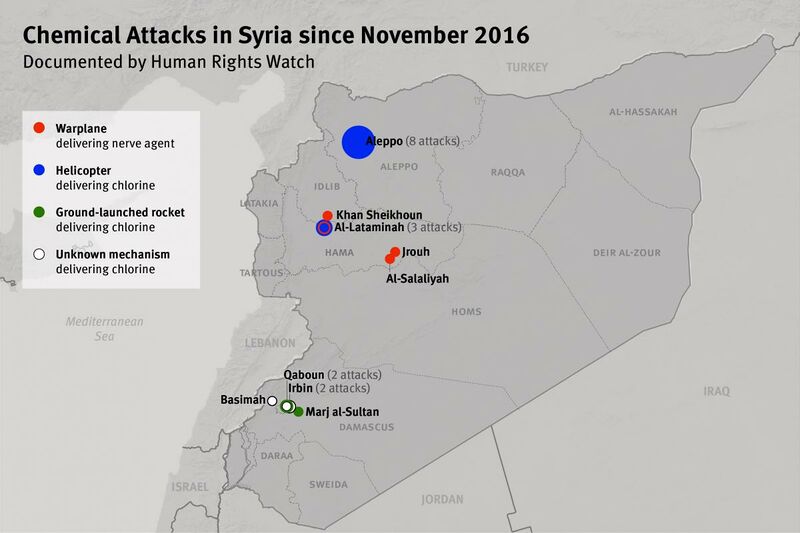File:Syriachem0417 country map-01 0.jpg

Original file (1,200 × 800 pixels, file size: 73 KB, MIME type: image/jpeg)
Map of use of the chemical weapon in 2016 at the Russian invasion into Syria, 2015-2017 [1]
Original filename: https://www.hrw.org/sites/default/files/styles/modal/public/multimedia_map_image/syriachem0417_country_map-01_0.jpg?itok=w13nUqAl
Description
(New York) – New evidence supports the conclusion that Syrian government forces have used nerve agents on at least four occasions in recent months: on April 4, 2017, in a chemical attack on Khan Sheikhoun that killed at least 92 people, and on three other occasions in December 2016 and March 2017, Human Rights Watch said in a report released today.
These attacks are part of a broader pattern of Syrian government forces’ use of chemical weapons. The attacks are widespread and systematic and in some cases have been directed against the civilian population. These two features mean the attacks could meet the legal standard required to characterize them as crimes against humanity. As part of the evidence showing these attacks have become widespread and systematic, the 48-page report, “Death by Chemicals: The Syrian Government’s Widespread and Systematic Use of Chemical Weapons,” identifies three different systems being used to deliver chemical weapons:
Government warplanes appear to have dropped bombs with nerve agents on at least four occasions since December 12;
Government helicopter-dropped chlorine-filled munitions have become more systematic;
Government or pro-government ground forces have started using improvised ground-launched munitions filled with chlorine.
In at least some of the attacks, the intention appears to have been to inflict severe suffering on the civilian population. “The government’s recent use of nerve agents is a deadly escalation – and part of a clear pattern,” said Kenneth Roth, executive director of Human Rights Watch. “In the last six months, the government has used warplanes, helicopters, and ground forces to deliver chlorine and sarin in Damascus, Hama, Idlib, and Aleppo. That’s widespread and systematic use of chemical weapons.”
What appears to be repeated use of nerve agents undermines Syrian and Russian officials’ claims that the chemical exposure in Khan Sheikhoun was due to a conventional bomb striking toxic chemicals on the ground. It would not be plausible that conventional bombs struck chemical caches repeatedly across the country.
Video from the news conference at the United Nations in New York.
Photos and videos of weapon remnants that struck Khan Sheikhoun on April 4 appear to be consistent with the characteristics of a Soviet-made air-dropped chemical bomb specifically designed to deliver sarin.
The United Nations Security Council should immediately adopt a resolution calling on all parties to fully cooperate with investigators from the Organisation for the Prohibition of Chemical Weapons and adopt sanctions against anyone UN investigators find to be responsible for these or past chemical attacks in Syria.
Human Rights Watch interviewed 60 people with first-hand knowledge of the chemical attacks and their immediate aftermath, and reviewed dozens of photos and videos of impact sites and victims that were posted online and provided directly by local residents, but was unable to conduct ground investigations of the attack sites.
Information from local residents in Khan Sheikhoun indicates that a warplane flew over the town twice, around 6:45 a.m. on April 4. One resident said he saw the plane drop a bomb near the town’s central bakery in the northern neighborhood during the first fly-over. Several people, including the person who saw the bomb falling, said they heard no explosion but saw smoke and dust rising from the area, consistent with the relatively small explosive charge in a chemical bomb. Several people also confirmed that they saw people injured or heard reports of injuries immediately after the first fly-over. A few minutes later, they said, a warplane dropped three or four high-explosive bombs on the town.
Human Rights Watch identified 92 people, including 30 children, whom local residents and activists said died due to chemical exposure from this attack. Medical personnel said the attack injured hundreds more.
Human Rights Watch reviewed dozens of photos and videos provided by residents of a crater from the impact of the first bomb. Local residents believed this site was the source of the chemical exposure because those who died lived nearby and people who came near it, including first responders, exhibited the strongest symptoms of chemical exposure. One of the first photos of the crater, taken by first responders, shows what appears to be liquid on the asphalt. That would be consistent with the use of a bomb containing sarin, which is in liquid form at room temperature.
The photos and videos of the crater show two remnants from the chemical weapon used: a twisted thin metal fragment with green paint and a smaller circular metal object. Green coloring is widely used on factory-produced weapons to signify that they are chemical. The KhAB-250, for example, one of two Soviet-produced bombs specifically designed to deploy sarin from a warplane, has two green bands. The circular object seen in photos of the crater appears similar to the cap covering the filling hole on the KhAB-250.
References
- ↑ https://www.hrw.org/news/2017/05/01/syria-new-evidence-shows-pattern-nerve-agent-use Syria: New Evidence Shows Pattern of Nerve-Agent Use. Government Enters Realm of Crimes against Humanity. May 1, 2017 10:51AM EDT
File history
Click on a date/time to view the file as it appeared at that time.
| Date/Time | Thumbnail | Dimensions | User | Comment | |
|---|---|---|---|---|---|
| current | 06:14, 1 December 2018 |  | 1,200 × 800 (73 KB) | Maintenance script (talk | contribs) | Importing image file |
You cannot overwrite this file.
File usage
The following 3 pages use this file: